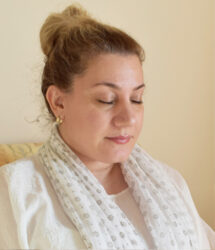A Way to Reduce Anxiety and Fear

Being afraid is a terrible feeling. Even experience of its less sharp, more generalized version–anxiety–is uncomfortable and debilitating. And everyone justifiably has these feelings from time to time. But some women find that fear and anxiety are characteristic features of their lives.
Fear is completely natural—it can trigger (or is triggered by) biological, biochemical, neurological and psychological reactions to perceived danger. Fear can be powerful and overwhelmingly debilitating or highly motivating, and it can be subtler—like anxiety—quietly nagging at our peace of mind. It warns us that loss of happiness, safety, or physical wellbeing is impending.
When we are often exposed to excessive fear-producing stress, the result may be a hyper-vigilant stress-response that harms our psychological and physical health as well as aging us. The problem is that in the modern world many things that may elicit fear, such as a surprise quiz, a stern look from the boss, or the daily news, may create fear that shuts down the executive functions of the brain, all of which we need to deal with complex situations.
The physiological effect during the practice of the Transcendental Meditation (TM) technique is the opposite of the stress response. Studies show that how we react to stressful events in the environment depends on how stressful we are feeling inside. In published studies, TM meditators have been shown to experience less of these internal stress responses and startle responses compared to non-meditating control subjects of the same age and demographics.
The National Institute of Mental Health site states, “People who have PTSD may feel stressed or frightened even when they are not in danger.” PTSD affects at least 10 percent of women in America. Published studies show that TM decreases multiple features of post-traumatic stress disorder, including anxiety.
Transcendental Meditation increases our inner balance, calmness and resilience so that fear and anxiety are triggered more rarely. In this way, TM offers significant relief from unhelpful fear and its consequences.
Psychologist and published researcher Dr. David Orme-Johnson explains:
During and after the practice of the TM technique, people often report feeling less stressed, happier, and more comfortable with themselves. This feeling typically lasts for some time after the TM session ends. Over time, this feeing builds up to last more and more in activity, and it is the antithesis of fear. The physiology of TM is the exact opposite of fear—reduced respiration, heart rate, increased skin resistance, etc. This physiology lasts more and more in activity after TM until no more fear is felt at any time.
Women’s everyday fears
Women’s fears and anxieties are often centered on internal issues, like relationships, parenting and aging. With the regular practice of the TM technique, women experience increased collectedness, self-esteem and inner strength. We are more in the moment, self-reliant, and able to enjoy what is going on.
As psychotherapist Judith Pomerantz wrote, “The Transcendental Meditation technique opens our awareness to an inner reservoir of serenity—we become calm, centered and more at ease—even in the midst of a hectic demanding day. TM reduces stress and expands awareness so we become more alert to the needs of others as well as ourselves. It quiets the mind so we can listen better. It reduces anxiety and lets the heart flow so that we can be more generous and nurturing.”
Peace of mind
A lovely woman named Charlotte who had been practicing the TM technique for 30 years was asked what she thought was the most precious benefit she’d received from TM. Without hesitation she replied simply, “No more fear.”
What an astonishing, most promising and wonderful answer. No more anxiety or fear. At all. Ever. The only way to achieve such a thing is to be completely deeply connected to the most invincible level of oneself. And this is what Transcendental Meditation offers.
About the Author
Janet Hoffman is the executive director of TM for Women Professionals, a division of TM for Women in the USA





